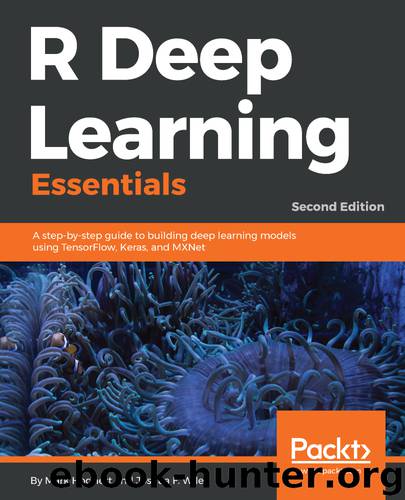R Deep Learning Essentials by Mark Hodnett

Author:Mark Hodnett
Language: eng
Format: epub
Tags: COM042000 - COMPUTERS / Natural Language Processing, COM004000 - COMPUTERS / Intelligence (AI) and Semantics, COM044000 - COMPUTERS / Neural Networks
Publisher: Packt Publishing
Published: 2018-08-24T10:31:09+00:00
Figure 6.1: An example of a learning curve which plots accuracy by data size
In this case, accuracy is in a very narrow range and stabilizes as the # instances increase. Therefore, for this algorithm and hyperparameter choice, adding more data will not increase accuracy significantly.
If we get a learning curve that is flat like in this example, then adding more data to the existing model will not increase accuracy. We could try to improve our performance by either changing the model architecture or by adding more features. We discussed some options for this in Chapter 5, Image Classification Using Convolutional Neural Networks.
Going back to our binary classification model, let's consider how we could we use it in production. Recall that this model is trying to predict if customers will return in the next x days. Here is the confusion matrix from that model again:
Predicted
Actual 0 1
0 10714 4756
1 3870 19649
If we look at how the model performs for each class, we get a different accuracy rates:
For Actual=0, we get 10714 / (10714 + 4756) = 69.3% values correct. This is called specificity or the true negative rate.
For Actual=1, we get 19649 / (3466 + 19649) = 85.0% values correct. This is called sensitivity or the true positive rate.
Download
This site does not store any files on its server. We only index and link to content provided by other sites. Please contact the content providers to delete copyright contents if any and email us, we'll remove relevant links or contents immediately.
| Computer Vision & Pattern Recognition | Expert Systems |
| Intelligence & Semantics | Machine Theory |
| Natural Language Processing | Neural Networks |
Algorithms of the Intelligent Web by Haralambos Marmanis;Dmitry Babenko(8586)
Test-Driven Development with Java by Alan Mellor(7543)
Data Augmentation with Python by Duc Haba(7431)
Principles of Data Fabric by Sonia Mezzetta(7195)
Learn Blender Simulations the Right Way by Stephen Pearson(7123)
Microservices with Spring Boot 3 and Spring Cloud by Magnus Larsson(6941)
RPA Solution Architect's Handbook by Sachin Sahgal(6349)
The Infinite Retina by Robert Scoble Irena Cronin(6057)
Hadoop in Practice by Alex Holmes(6055)
Jquery UI in Action : Master the concepts Of Jquery UI: A Step By Step Approach by ANMOL GOYAL(5911)
Big Data Analysis with Python by Ivan Marin(5830)
Life 3.0: Being Human in the Age of Artificial Intelligence by Tegmark Max(5447)
Pretrain Vision and Large Language Models in Python by Emily Webber(4786)
Infrastructure as Code for Beginners by Russ McKendrick(4560)
WordPress Plugin Development Cookbook by Yannick Lefebvre(4273)
The Age of Surveillance Capitalism by Shoshana Zuboff(4192)
Functional Programming in JavaScript by Mantyla Dan(4166)
Embracing Microservices Design by Ovais Mehboob Ahmed Khan Nabil Siddiqui and Timothy Oleson(4056)
Applied Machine Learning for Healthcare and Life Sciences Using AWS by Ujjwal Ratan(4038)
